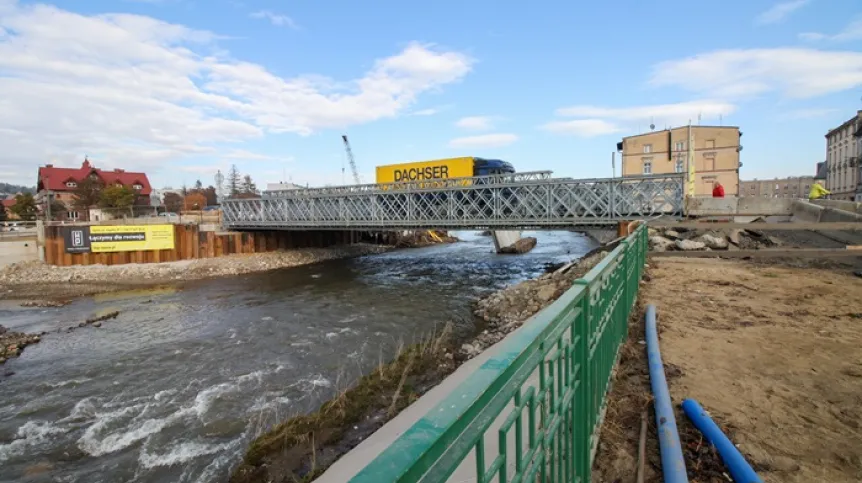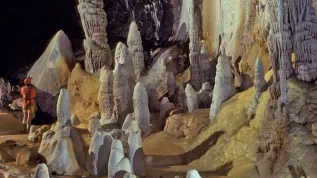
Flood in southern Poland, numerous local floods with simultaneous hydrological drought and record low levels of rivers including the Vistula. The phenomena we encountered in 2024 are a new reality that we must prepare for also in Poland, says ecohydrologist Sebastian Szklarek, PhD.
'Considering everything that happened with the climate and related atmospheric phenomena in 2024, we can say that this is a new standard. The September flood in Poland was also a symptom of this changing world. While it is still a fairly rare phenomenon in our country, it was intensified by the warming climate, which has influenced the events in recent years', says Sebastian Szklarek, PhD, author of the blog Świat Wody, ecohydrologist from the European Regional Centre for Ecohydrology of the Polish Academy of Sciences under the auspices of UNESCO.
Data collected by international institutions show the global temperature increase. According to NOAA (National Oceanographic and Atmospheric Administration), the global surface temperature of the Earth in the period from January to November was the highest in the 175-year history of measurements, amounting to 1.28 degrees Celsius above the average from 1901-2000. According to November data from the EU's Copernicus Climate Change Service, in the past year the average global temperature was as much as 1.62 degrees Celsius higher than the level before the era industrial.
Szklarek reminds that the increase in global temperature intensifies weather phenomena, also by raising the temperature of ocean and sea waters. 'And if the water temperature is higher, then all the processes related to it and occurring in it also intensify', the expert points out.
A good example of these processes is the September flood in the southern Oder River Basin in Poland, in Czechia and in other countries of Central Europe. It was caused by a cold low, which periodically flows from the vicinity of the UK south towards the Gulf of Genoa.
'There, it usually gains moisture and moves towards us. Then it collides with warm air from Eastern Europe, and the moisture changes into rain. However, this year, the low was intensified by climate change, because the warmer the waters, the more they evaporate, and the warmer the air, the more moisture it can hold before it turns into precipitation. That is why this famous low was able to carry more water from the Italian region towards us. And because of that, the rainfall was more intense than we would normally expect', the ecohydrologist describes.
Another symptomatic thing for our region is more frequent torrential rainfall, when the amount of rain in a few hours is equal to, for example, monthly norms, resulting in flash floods on a local scale.
When we look at recent years, most cities have been affected by this phenomenon. It happens sometimes, but if we look at it historically, the frequency of these phenomena is increasing', he says.
On the other hand, high temperatures contribute to the opposite phenomenon - drought, which, according to the Institute of Soil Science and Plant Cultivation - National Research Institute, in the past year occurred throughout Poland between July 11 and September 10.
'Temperature increases mean that even if it rains, this water disappears very quickly through evaporation. This factor contributes to the development of agricultural drought to a large extent', the ecohydrologist said.
He adds that the wet winter and the beginning of spring 2024 caused the so-called meltwater floods, which slightly delayed the drought. However, the warmer than usual spring months, and especially the summer and autumn months, caused water to 'start to escape from us quite early, and significantly'.
'We think about evaporation mainly in the summer, because then we have high temperatures, reaching 30 degrees. We pay less attention to the fact that, for example, water also evaporates in winter, when we have positive temperatures. Of course, this evaporation is smaller than in summer, but as studies show, winter evaporation increases faster in percentage terms than in previous years', the expert explains.
The effects of water evaporation could be seen even by casually observing the water level in the Vistula. In the first half of September, when southern Poland was struggling with floods, the water level of the longest Polish river reached record lows. The lowest - 20 centimetres - was recorded at the Warsaw hydrological station Bulwary Wiślane.
'What the water gauge at Bulwary Wiślane shows is a reflection of everything that is happening with water on about one quarter of Poland's territory. Everything that flows into the Vistula from the Tatras, from the Bieszczady Mountains, is later reflected in what is happening on the Vistula in Warsaw. The fact that we had a record low level is the result of many small streams, small rivers in this part of the country drying up', Szklarek emphasises.
The ecohydrologist points out that in the face of such phenomena, which are intensifying year by year, we must prepare for a new reality. These preparations - despite education and communication of threats - do not inspire optimism.
'After all, climate models have been predicting the direction in which the climate would be heading for years. And we can see the pace of response of states and societies to these warnings', he says.
Now - in his opinion - we should prepare for future phenomena with a certain 'margin'. 'If we prepare for what is currently happening, it will soon be insufficient. We need to prepare not for the rainfall that is currently happening, but multiply it, let's say, by two. Prepare for phenomena that are twice as intense, because that is the direction it is heading', he predicts.
However - as Szklarek reminds - 'slowing down the speeding train' of climate change is not easy, because the key is to reduce the burning of fossil fuels, which contribute to greenhouse gas emissions. Otherwise, it will not work.
Actions that reduce the negative effects of climate phenomena can be taken a little faster. In the case of protection against floods, the best solution, according to the PAP interviewee, is to 'stop the water in the place where it falls'.
'This is also a drought prevention, because if we stop the water, we create moisture in the soil, which will reduce the risk of both forest fires and agricultural drought. If we ensure that the water soaks in, it slowly seeps underground towards the nearest river. This, in turn, stabilises water flows during the period with no rain, which means it reduces the risk of low water levels in rivers', Szklarek describes.
Stopping water is much easier in lowland areas, because its runoff is limited by the terrain itself. Apart from 'de-concreting' cities, which is often discussed, it is enough to deepen the area in places such as parks and lawns, creating basins that will retain water.
'Lawns in cities are usually above street level, and it would be enough to reverse this trend to have large areas that could retain water. It is more difficult in the mountains, which is why in some mountain regions, the best solution to protect towns would be dry polders, i.e. areas that could absorb excess rain', the researcher says.
Appropriate solutions can also be used in cities. For example, key infrastructure or important institutions should not be placed on lower floors of buildings. Super-watertight windows should be used on lower floors. In some cities, fast barriers are also used, placed in rails on both sides of the street in times of danger.
'This creates a barrier that redirects water through a given location so that it causes the least possible damage, protecting key and densely populated areas. Of course, it is expensive, but you have to calculate whether it will not be cheaper than having to rebuild the flooded property', Szklarek emphasises. (PAP)
Ewelina Krajczyńska-Wujec
ekr/ agt/ ktl/













